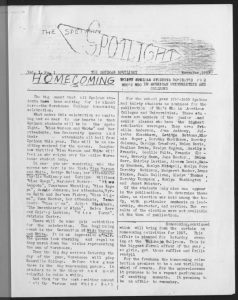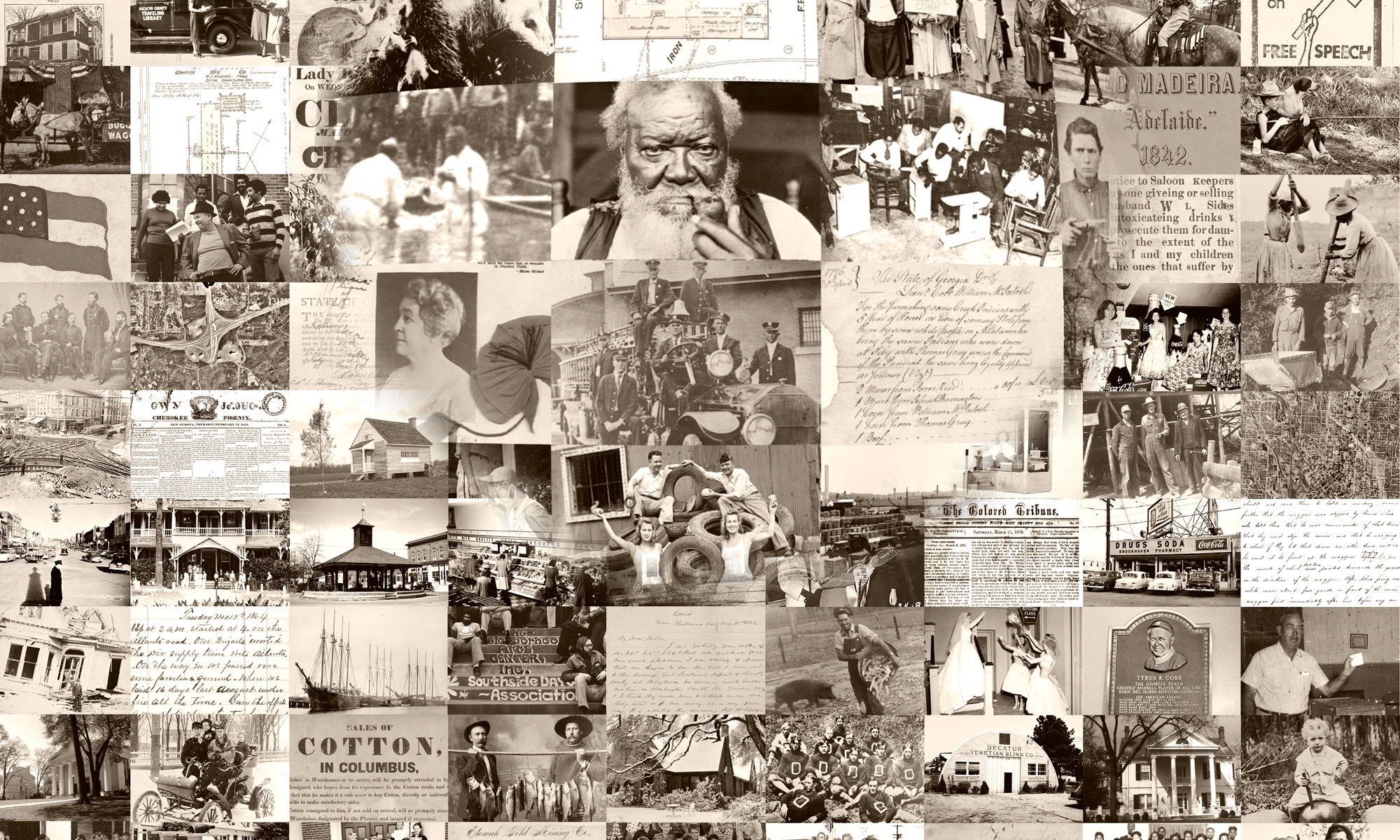
The Digital Library of Georgia (DLG) is pleased to announce that, in conjunction with the Atlanta University Center (AUC) Robert W. Woodruff Library, several student newspapers from Spelman College, Clark Atlanta University, and Morris Brown College are now available for viewing at the Georgia Historic Newspapers web site at https://gahistoricnewspapers.galileo.usg.edu. These resources, part of the “Our Story”: Digitizing Publications and Photographs of the Historically Black Atlanta University Center Institutions project, administered by the Council on Library and Information Resources (CLIR)’s Digitizing Hidden Special Collections and Archives awards program, which is supported by The Andrew W. Mellon Foundation.
When studying historically black colleges and universities (HBCUs), patrons will find these newspapers beneficial for interdisciplinary examinations of African American achievement, African American leadership, and student life. These publications are significant, in that they were a means of self-expression for African American students to convey their opinions of college life and society within a forum that validated their thoughts and opinions. Digitization of these publications could significantly increase the scholarship written about the AUC, enable patrons to enhance the historical record, and contribute to a more comprehensive narrative through the representation of the under-documented.
Christine Wiseman, Head, Digital Services Department at Atlanta University Center Robert W. Woodruff Library states: “Through the “Our Story” project, the AUC Woodruff Library has significantly expanded the breadth and depth of resources available about the history of the world’s largest consortium of HBCUs. Without support from CLIR and project partners, an initiative of this scale would not be possible. Making these student newspapers available online for students, scholars and the general public should contribute to the narrative and research on the history of African American higher education and its impact on society.”
The publications include:
The Spelman Spotlight
https://gahistoricnewspapers.galileo.usg.edu/lccn/sn81304549/
The New Spelman Spotlight
https://gahistoricnewspapers.galileo.usg.edu/lccn/sn81304580/
The Spotlight
https://gahistoricnewspapers.galileo.usg.edu/lccn/sn81306945/
The BluePrint
https://gahistoricnewspapers.galileo.usg.edu/lccn/sn81308021/
The Spelman Spotlight began as Spelman Reflections on February 1, 1956. In November of 1957, the masthead became Spelman Spotlight, but the design and editorial focus of the newspaper remained the same. The paper focused on matters concerning Spelman College and the Atlanta University Center. Within the pages of the Spotlight, one could find news related to faculty, student government, and campus life. The Spotlight briefly became the Spelman Bulletin for the November 1958 and March 1959 issues before returning to its previous title. In November of 1959, The Spotlight underwent a redesign. As the Spotlight settled into its new format, the topics it covered expanded beyond the range of Spelman College and included news related to the American Civil Rights Movement. In 2013, the Spotlight became the BluePrint. The BluePrint continues today as a student-run publication at Spelman College.
The Campus Mirror
https://gahistoricnewspapers.galileo.usg.edu/lccn/sn38019897/
The Campus Mirror was first published in October 1924 as a monthly publication managed and edited by the students of Spelman College. The paper featured editorials, campus news, events, speeches, local advertisements featuring African American-owned businesses, and photographs of classes and organizations that document African American female leadership, and the experiences of African American women pursuing higher education from the 1920s to the 1950s.
In addition to its news coverage, literary works by students and advice for interviews or studying could be found in the Mirror‘s pages. A special commencement issue was published at the end of each academic year. These issues included photographs and covered the graduating and incoming classes, making the publication an important genealogical resource. The newspaper’s final issue circulated in May 1950 after 26 years of covering campus life.
- Clark Atlanta University Panther
https://gahistoricnewspapers.galileo.usg.edu/lccn/sn39724533/
The Panther was a monthly newspaper published by Clark College students during the academic year. In 1972, the student government chose Frank W. Johnson Jr. as editor-in-chief. Under Johnson’s leadership, the paper began to feature political and social issues beyond the confines of Clark College. In an April 1973 issue, Johnson announced that the Panther would expand coverage to include grassroots efforts in areas such as welfare, prison reform, black politics, police brutality, liberation movements in Africa, and other topics of the day. Also found those 1970s issues are calls for student submissions, guest editorials, and statements from school administration.
- The Wolverine Observer
https://gahistoricnewspapers.galileo.usg.edu/lccn/sn54110460/
The Wolverine Observer was a student-run publication serving Morris Brown College and its community under the direction of Professor V. C. Clinch. By the 1960s, the Observer was a member of the Intercollegiate Press (later the Associated Collegiate Press) and was largely run by the students themselves. The Observer sought to report news of interest to the Morris Brown College community and featured student editorials throughout its pages.
Holly A. Smith, College Archivist, Women’s Research & Resource Center at Spelman College says: “The Campus Mirror is an amazing publication that many researchers outside of the Spelman community might not be aware of. It provides a rich and enlightening view of campus activities and news from the students’ perspective prior to the yearbook or the Spelman Spotlight, the long-running student newspaper. Making the Mirror accessible via the Digital Library of Georgia will increase awareness and use of this unique publication, and shed further light on the history of the college, the students, and the overall campus community.”
The Georgia Historic Newspapers Archive web site provides access to these newspapers, enabling full-text searching and browsing by date and title. The site is compatible with all current browsers and the newspaper page images can be viewed without the use of plug-ins or additional software downloads. The archive is free and open for public use.
About the Atlanta University Center (AUC) Robert W. Woodruff Library
The Atlanta University Center (AUC) Robert W. Woodruff Library serves as the center of the academic village for Clark Atlanta University, the Interdenominational Theological Center, Morehouse College, and Spelman College, providing the highest level of information resources and services in support of teaching and learning, scholarship and cultural preservation of the Atlanta University Center.
About Spelman College
Spelman College, a historically Black college and a global leader in the education of women of African descent, is dedicated to academic excellence in the liberal arts and sciences and the intellectual, creative, ethical, and leadership development of its students. Spelman empowers the whole person to engage the many cultures of the world and inspires a commitment to positive social change.
About Clark Atlanta University
Building on its social justice history and heritage, Clark Atlanta University is a culturally diverse, research-intensive, liberal arts institution that prepares and transforms the lives of students. CAU is located in the heart of Atlanta which is the epicenter of the Civil Rights Movement and modern center of emerging technologies and innovation. Ignited by its history, CAU is committed to delivering education that is accessible, relevant, and transformative..
About Morris Brown College
Morris Brown College was founded on Christian principles in 1881 by the African Methodist Episcopal Church and is chartered by the State of Georgia as a private, coeducational, liberal arts college engaged in teaching, research, and public service in the arts, humanities, social and natural sciences and professional programs.
The mission of Morris Brown College is to provide educational opportunities in a positive and nurturing environment that will enable its students to become fully functional persons in our global society. The College prepares graduates to live meaningful and rewarding lives, thereby enabling them to make socially constructive and culturally relevant contributions to society.
Morris Brown College, in its commitment to academic excellence, provides experiences that foster and enhance intellectual, personal, and interpersonal development for students who have demonstrated the potential to compete in a challenging undergraduate liberal arts program of study.
About the Digital Library of Georgia
Based at the University of Georgia Libraries, the Digital Library of Georgia https://dlg.usg.edu is a GALILEO initiative that collaborates with Georgia’s libraries, archives, museums, and other institutions of education and culture to provide access to key information resources on Georgia history, culture, and life. This primary mission is accomplished through the ongoing development, maintenance, and preservation of digital collections and online digital library resources. DLG also serves as Georgia’s service hub for the Digital Public Library of America and as the home of the Georgia Newspaper Project, the state’s historic newspaper microfilming project.


